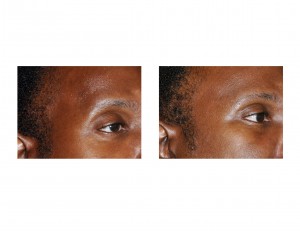
ALTERNATIVES
Alternatives for improving the appearance of a depressed or hollowed temporal area include synthetic injectable fillers, fat injections, or augmentation using a variety of bone cements.
GOALS
The goal of temporal augmentation is to improve its appearance from a hollowed (concave) profile to a flatter one. In rare cases, the patient may even have a more convex profile if they desire.
LIMITATIONS
The limitations of temporal augmentation with implants is the size and shape of the implanted material. The thickness of the implant and its height and length determine how much augmentation is achieved.
EXPECTED OUTCOME
Expected outcomes include the following: temporary swelling and bruising around the temples and eyes, temporary numbness of the overlying temporal skin, and four to six weeks after surgery to see the final temporal shape.
RISKS
Significant complications from temporal implants are extremely rare. More likely risks include infection, permanent temporal hairline scars, overcorrection or undercorrection of the temporal profile, and implant/augmentation asymmetry. Any of these risks may require revisional surgery for improvement.
ADDITIONAL SURGERY
Should additional surgery be required for temporal implant revision and/or replacement, this will generate additional costs.


